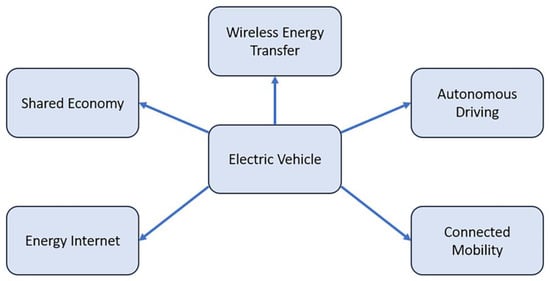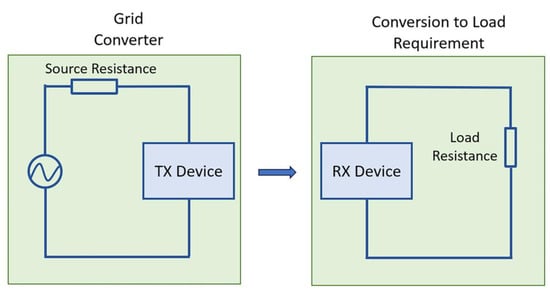You're using an outdated browser. Please upgrade to a modern browser for the best experience.
Please note this is a comparison between Version 1 by Lorant Andras Szolga and Version 2 by Catherine Yang.
Human operators’ presence for periodic maintenance is required in all transportation infrastructures; while providing a sustainable solution with Electric Vehicles (EVs) network, each vehicle needs servicing to maintain its robustness. Parts, such as reactive components from converter units, namely electrolytic capacitors, require periodic replacement. Other components, such as microcontroller PCBs (Printed Circuit Boards), are prone to EEPROM (Electrically Erasable Programmable Read-Only Memory) decay and data loss. As fossil fuel is mainly used in generating energy and biosphere degradation remains a concern due to terrain expansion, wireless energy transfer could be an immediate solution for substituting the current transportation infrastructure for a robust and renewable solution. When migrating an entire transportation infrastructure to wireless energy transmission, periodic maintenance of energy transmitters, for example, orbital space stations, would be necessary. This requires the operator’s presence, and health becomes important in maintaining the robustness of this hypothetical sustainable transportation infrastructure. Multiple health concerns are related to the effect of conversion units, typically used in electric vehicles and other hybrid and modern combustion engine means of transportation. These units cover both wire-based and wireless energy transmission. As covered in further sections, several already implemented features of vehicles could negatively impact the operator’s health because such features are mainly based on wireless energy transfer, while other functionalities cause EMI (Electromagnetic Interference) perturbation.
- energy management systems
- electric vehicles
- hybrid powertrain
1. Modern Features of Electric Vehicles
The currently in-service ICE vehicles could not be adapted to a sustainable transportation solution without major recalls or significant environmental damage. Although the generic purpose of electric vehicles provides more sustainability, this infrastructure insufficiently compensates for the greenhouse gas emissions due to the non-sustainable electricity generation for charging stations.
Besides the partially renewable feature of electric vehicles, producers have implemented various additions to facilitate several aspects of operation and communication, as shown below in Figure 125.

Figure 125.
Innovations for electric vehicles.
The wireless power transfer concept only closes the charging circuit through magnetic coupling. As its name suggests, autonomous driving involves the possibility of driving such vehicles partially independently from the driver’s commands by taking measurements of the surrounding environment. Connected mobility connects automobiles to various traffic objects, such as other vehicles, stations, or traffic signals. The shared economy concept represents the possibility of sharing operating resource costs, while the energy internet unifies the energy infrastructures (electric, transportation, or thermal) into one platform [1][138].
Although these systems provide utility to vehicles in production, many features are based on WiFi (Wireless Fidelity) technology. Such wireless transmission systems have been researched to have adverse biological effects. As will be discussed, even short-intensity radiation could negatively impact health during prolonged exposure.
2. Wireless Charging Systems
Wireless charging energy transfer has become a popular alternative to conventional inlet-plug charging systems and underwent intense studies about integration into the infrastructure [2][139]. Because wireless charging is more environmentally and user-friendly, switching to WPT (Wireless Power Transfer) may be a better option [3][140]. A block diagram for such energy conversion systems is presented in Figure 26.

Figure 26.
WPT charger block diagram.
The WPT system provides several advantages in contrast to wire charging. This charging topology does not require a physical connection between the vehicle and the station, providing a safer and, in some cases, more efficient charging circuit [4][141]. Moreover, certain standards offered compatibility between different chargers [5][142], allowing the use of charging stations to a wider extent for electric vehicles.
As for the vehicle-to-grid concept, different adaptation methods could be used to integrate a WPT system into such a circuit [6][143]. This would allow a bidirectional energy transfer, further extending the capabilities of such charging topologies by charging or providing energy at certain times. However, when applied to vehicles in traffic, a wireless charging system based on magnetic coupling requires an accurate alignment between the vehicle and road inductors [7][144]. As an alternative to this limitation, microwaves could provide an alternative transfer of energy, eliminating the need for WPT methods and eliminating the need for charging stations [8][145]. However, the harm risk of using microwaves for energy transfer is greater, meaning that irradiation can occur and have negative biological consequences.
3. Health Impact Concerns for Communication Networks
Modern electronic equipment poses the danger of long-term exposure to NIR (Non-Ionizing Radiation) for all previously covered renewable and non-renewable vehicle topologies. Multiple sources of such radiation can be identified, as shown in Table 15.
| Source | Frequency Band (MHz) 1 |
|---|---|
| Digital audio broadcasting | 200 |
| Terrestrial trunked radio | 390 |
| GSM mobile phones | 935 |
| DCS mobile phones | 1750 |
| Tx 3G mobile phones | 1950 |
| Wireless networks and microwave ovens | 2450 |
| Bluetooth | 2500 |
| 4G mobile phones | 3700 |
| 5G mobile phones | 52,000 |
1 These values are an approximation for all entries.
The data presented above show the tendency to increase the frequency band as the data transfer rate increases. Television, microwave ovens, mobile phones, and most wireless communication or energy transfer circuits are sources of non-ionizing radiation. The International Agency for Research on Cancer classified this type of radiation as a possible carcinogen, meaning that even with negligible power levels, prolonged exposure to NIR cannot be neglected [10][11][147,148].
Wireless data communication occurs in most features of modern internal combustion engines or electric vehicles. The devices communicating data are often based on high-speed communication protocols, such as GPS (Global Positioning System), built-in WiFi, and radio frequency identification devices.
Studies have found that non-ionizing radiation harms human tissue, although more research is needed on electromagnetic fields emitted by mobile phones. Also, long-term evaluation of WiFi exposure is challenging, and results might be mixed with other electromagnetic radiation types. Below a certain threshold, some researchers consider NIR to be not harmful [12][13][149,150].
However, studies have shown harmful effects after long-term communication network use from mobile phones, including intracranial tumors [14][151]. Epidemiological reports have evaluated radiation exposures still below the ARPANSA (Australian Radiation Protection and Nuclear Safety Agency) standards originally mentioned as safe but found a possible linkage between salivary gland tumors and wireless communication [15][16][152,153]. Another possible linkage of pre-natal autism was reported as a consequence of long-term WiFi effects [17][154]. Limiting the electromagnetic perturbing exposure functions to maintain a safe environment for wireless communication and high-power conversion circuits, for which standards were set for switching frequencies between 3 kHz and 100 kHz [18][155].
4. Biological Effects of Wireless Energy Conversion Systems
During the studies mentioned in [19][156], it has been determined that cerebral spinal fluid has the highest electrical conductivity of all human tissues and fluids tested. The reference DC converter was operated at 85 kHz to achieve a wireless power transfer, and the study was conducted for a male human model. The results show the potential hazard related to the absorption of electromagnetic interference by multiple human body parts.
As for the improvement of switching parts in DC converter units, an experimental study points to the possible harmful effects of long-term exposure to low-intensity NIR. By changing the transistor types, electromagnetic compatibility can worsen [20][157]. As demonstrated by Fourier series decomposing, many high-frequency harmonics will be present in the proximity of DC converters. Even so, guidelines were applied to minimize the harmful impact on human health [21][158].
Overall, the higher the frequency of radiation, the more hazardous the long-term effect of wireless communication and energy transfer systems. An increase in data transfer rate involves an increase in switching frequency, which extends closer to the ionizing radiations domain; such radiations are proven to dislocate electrons and provide a greater health risk.
